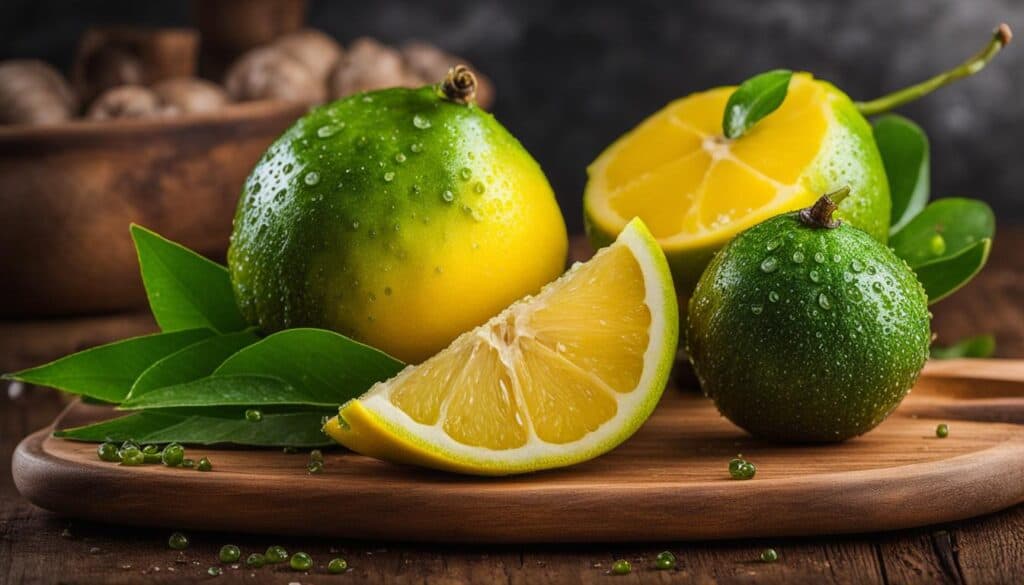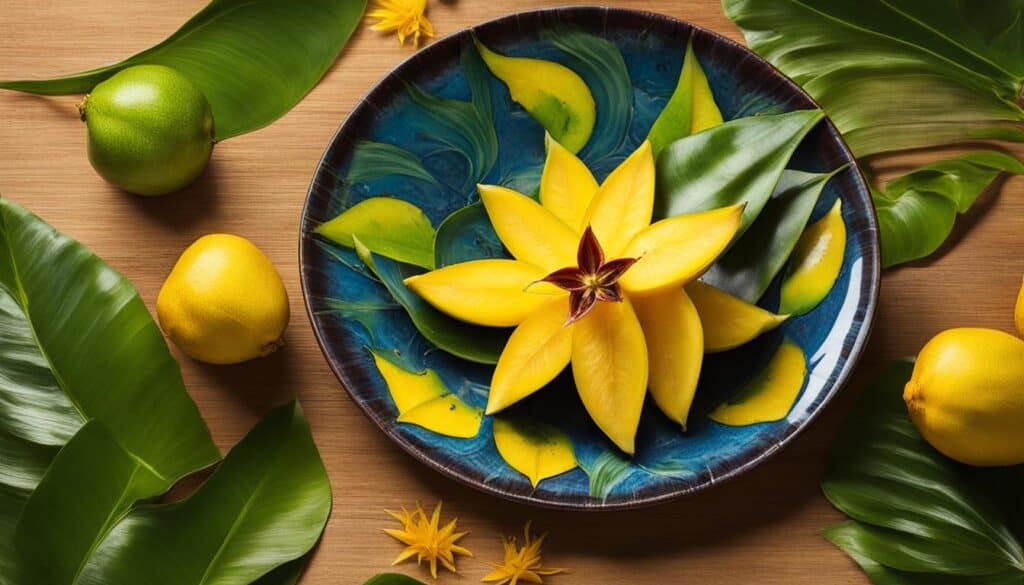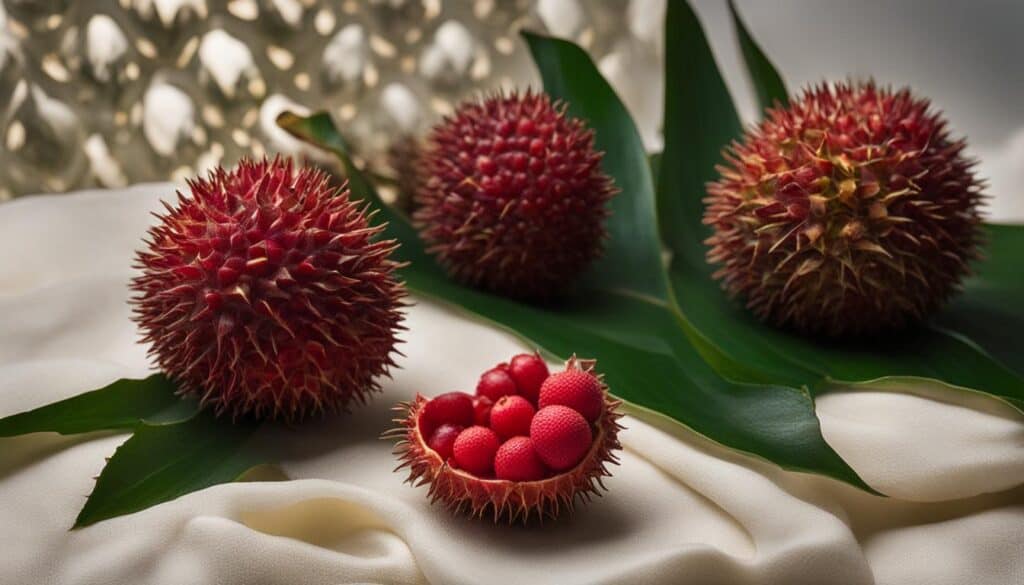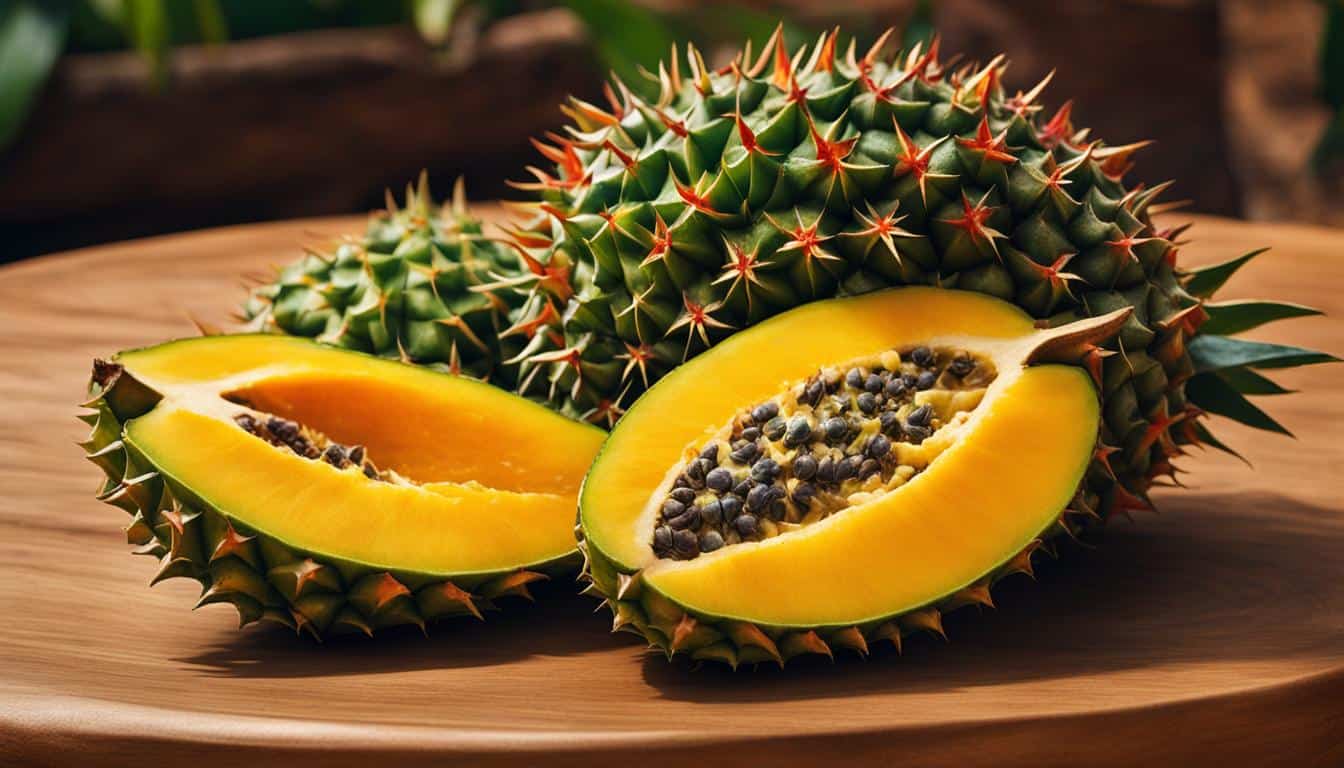When it comes to tropical and exotic fruits, Asia has an abundance to offer. From vibrant colors to unique tastes and textures, Asian fruits are a delightful culinary experience. Exploring local markets or Asian grocery stores can introduce you to a fascinating array of “new to you” fruits. In this article, we will take a closer look at some of the rare and exotic fruits from Asia, including the magnificent jackfruit, as well as other tropical delights.
Key Takeaways:
- Asia offers a diverse range of tropical and exotic fruits.
- Exploring local markets can introduce you to unique fruits like jackfruit.
- Jackfruit is the largest tree-borne fruit in the world.
- Other Asian fruits worth discovering include guava, mango, sapodilla, mosambi, starfruit, lychee, and tamarind.
- Each fruit offers its own distinct flavor and can be enjoyed in various ways.
Jackfruit – The King of Fruits
When it comes to tropical fruits, jackfruit undoubtedly reigns supreme. This exotic fruit, native to Asia and known as the king of fruits, holds the title for being the largest tree-borne fruit in the world. With its impressive size and unique flavor, jackfruit offers a delightful experience for fruit enthusiasts.
One of the key distinguishing features of jackfruit is its remarkable taste, which combines the sweetness of apple, the tanginess of pineapple, and the creaminess of banana. Its ripe flesh has a honey-like flavor that is simply irresistible. Whether enjoyed fresh as a fruit or used as a vegetarian substitute for chicken or duck in Asian cuisine, jackfruit offers a truly versatile culinary experience.
Aside from its delectable taste, jackfruit also boasts a range of health benefits. It is rich in nutrients, including vitamins A and C, potassium, and dietary fiber. The fruit’s fiber content aids digestion and promotes a healthy digestive system. Additionally, its abundance of antioxidants helps boost the immune system and protect against oxidative stress.
| Nutritional Content of Jackfruit | Amount per 100g |
|---|---|
| Calories | 94 |
| Carbohydrates | 24g |
| Fiber | 2.5g |
| Vitamin C | 11.7mg |
| Potassium | 303mg |
“Jackfruit is truly a remarkable fruit, both in terms of its size and its flavor. Its sweet and creamy flesh makes it a delicious addition to any meal, while its nutritional benefits add to its appeal. Whether you enjoy it fresh or use it in savory dishes, jackfruit is sure to satisfy your taste buds and provide you with a tropical fruit experience like no other.”
So if you’re looking to explore the world of exotic fruits, don’t miss out on jackfruit. With its impressive size, unique flavor, and abundance of nutrients, it truly lives up to its title as the king of fruits.
Guava – A Delightful Asian Fruit

Guava is a delightful Asian fruit that is beloved for its soft flesh and sweet taste. This tropical fruit comes in shades of pink, red, or white, adding a vibrant pop of color to any fruit bowl. The guava’s flavor is a delightful combination of pear and strawberry, making it a unique and delicious treat.
One of the great things about guava is its versatility. It can be enjoyed fresh, simply eaten skin-on, or used in a variety of culinary creations. You can blend guava into smoothies for a refreshing and tropical twist, or use it to make juices and fruit desserts. Its sweet and aromatic taste enhances the flavor of any dish.
Guava is a common fruit found across most of Asia. Whether you’re exploring a local market or visiting an Asian grocery store, you’re likely to come across this delightful fruit. Its popularity in Asia is a testament to its delicious taste and the joy it brings to those who indulge in its tropical goodness.
Benefits of Guava
Mango – The Taste of Summer
Mangoes are a beloved tropical fruit that brings the taste of summer to Asia and beyond. Known for its juicy flesh and delightful sweetness, the mango is a popular choice for desserts, smoothies, and even savory dishes. In India and Thailand, mangoes hold a special place in the culture and are celebrated during the annual mango season. The Indian mango, especially varieties like Alphonso, Banganpalli, and Neelam, are renowned for their exceptional taste and aroma. Thai mangoes, such as Nam Dok Mai and Khieo Sawoei Sampran, also have their own unique flavor profiles.
Indulging in a ripe mango is a sensory experience like no other. The vibrant colors and fragrant aroma of a perfectly ripened mango entice the senses even before taking the first bite. The smooth and velvety texture of the flesh melts in your mouth, while the sweet and tangy flavors transport you to tropical paradise. Whether enjoyed fresh, blended into a luscious smoothie, or used in tantalizing recipes, the mango is a true taste of summer that brings joy and refreshment.
“The mango is a gift from nature, a burst of sunshine in every bite.” – Unknown
Mango Varieties
Mangoes come in numerous varieties, each with its own characteristics and flavor profile. Here are a few notable mango varieties:
- Alphonso: Known as the “King of Mangoes,” Alphonso mangoes are prized for their rich, creamy texture and distinct sweet flavor.
- Banganpalli: Originating from Andhra Pradesh, India, Banganpalli mangoes are large, yellow, and have a unique sweet-tangy taste.
- Neelam: Neelam mangoes are popular in South India and are known for their bright orange flesh and sweet, juicy flavor.
- Nam Dok Mai: A popular Thai mango variety, Nam Dok Mai mangoes are small, golden-yellow fruits with a sweet and fragrant taste.
- Khieo Sawoei Sampran: Also known as the “Golden Diamond,” this Thai mango is famous for its golden-yellow skin and sweet, aromatic flesh.
No matter the variety, mangoes are a tropical treasure that brings delight to people all over the world. Their juicy sweetness and refreshing taste make them a perfect summer treat and a reminder of the bountiful flavors nature has to offer.
| Mango Variety | Origin | Characteristics | Flavor |
|---|---|---|---|
| Alphonso | India | Rich, creamy texture | Distinct sweet flavor |
| Banganpalli | Andhra Pradesh, India | Large and yellow | Sweet-tangy taste |
| Neelam | South India | Bright orange flesh | Sweet and juicy |
| Nam Dok Mai | Thailand | Small and golden-yellow | Sweet and fragrant |
| Khieo Sawoei Sampran | Thailand | Golden-yellow skin | Sweet and aromatic flesh |
Images source: SEO Writing
Sapodilla – A Sweet and Delicious Fruit
When it comes to tropical fruits, sapodilla, also known as Chickoo, is a delightful treat that shouldn’t be overlooked. This Indian fruit offers a unique flavor profile and a range of culinary possibilities. With its soft, delicious flesh in shades of pink, red, or orange, sapodilla has a subtle taste that combines the sweetness of a pear with the juiciness of a strawberry. It’s no wonder that sapodilla is commonly used in smoothies, juices, and fruit desserts across Asia.
What makes sapodilla even more enticing is its versatility. Whether you enjoy it fresh or incorporate it into your favorite recipes, sapodilla never fails to impress. Its natural sweetness adds depth to smoothies and fruit salads, while its smooth texture lends itself well to blending into refreshing drinks. Plus, sapodilla’s vibrant color makes it an attractive choice for garnishes and presentations.
The Nutritional Benefits of Sapodilla
Not only does sapodilla taste delicious, but it also brings plenty of health benefits to the table. This tropical fruit is rich in dietary fiber, which aids in digestion and promotes a healthy gut. Additionally, sapodilla is packed with vitamins and minerals, including vitamin C, vitamin A, and potassium. These nutrients support overall immune function and contribute to healthy skin and hair.
As a sweet indulgence, sapodilla can be enjoyed guilt-free knowing that it also contains antioxidants. These compounds help protect your cells from damage caused by harmful free radicals, promoting longevity and a reduced risk of chronic diseases.
Exploring the World of Exotic Fruits
As we venture into the world of tropical fruits, sapodilla has undoubtedly captured our attention with its tantalizing flavor and nutritional benefits. But there are still many more exotic fruits to discover. From the king of fruits, jackfruit, to the symbol of love, lychee, Asian fruits offer a sensory journey like no other. So why not embrace the diversity of flavors and explore the vibrant world of exotic fruits?
| Fruit | Taste | Uses | Region |
|---|---|---|---|
| Jackfruit | Apple, pineapple, banana | Fresh fruit, meat substitute | Indian Subcontinent |
| Guava | Pear, strawberry | Fresh fruit, smoothies, desserts | Asia |
| Mango | Rich, sweet | Fresh fruit, smoothies, salads, desserts | India, Thailand |
| Sapodilla | Pear, strawberry | Smoothies, juices, fruit desserts | Asia, particularly India |
| Starfruit | Sour (unripe), sweet (ripe) | Fresh fruit, preserves, pickles | Southeast Asia, Australia, South America, United States |
| Lychee | Strawberry, watermelon | Fresh fruit, Asian beverages | China, United States |
Mosambi – The Sweet Lime

When it comes to refreshing citrus fruits, mosambi, also known as sweet lime, takes center stage. This Indian fruit is praised for its unique flavor and delightful juiciness, making it a popular choice among fruit enthusiasts. Mosambi is often compared to oranges, but its distinct taste sets it apart, winning the hearts of many.
The sweet lime is not only a delicious treat but also a great source of nutrition. It is packed with essential vitamins and minerals, including Vitamin C, calcium, and antioxidants. The citrusy goodness of mosambi makes it a perfect choice to boost your immune system and promote overall well-being.
What makes mosambi stand out is its versatility. Its juice is a popular thirst-quencher in India and Pakistan, offering a refreshing and tangy experience. It can also be used to make delicious cocktails and mocktails, adding a burst of flavor. Moreover, the sweet lime can be enjoyed on its own or added to salads, desserts, and savory dishes for a zesty twist.
The Many Benefits of Mosambi
- High in Vitamin C, supporting a healthy immune system
- Rich in calcium, promoting strong bones and teeth
- Packed with antioxidants, protecting against free radicals and oxidative stress
- Helps in digestion and aids in maintaining a healthy gut
- Acts as a natural coolant, providing relief on hot summer days
Incorporating mosambi into your diet can add a burst of flavor and nutrition to your daily routine. Whether you enjoy its juice, savor its segments, or use it in creative recipes, this Indian fruit is sure to bring a taste of sunshine to your plate.
Starfruit – A Beautiful and Tasty Fruit

Starfruit, also known as carambola, is a delightful tropical fruit that is commonly found in Asia. It gets its name from its unique star-shaped appearance and waxy skin. The fruit is visually appealing and adds a touch of elegance to any dish or fruit platter.
Starfruit is not only beautiful, but it also offers a delicious taste. When unripe, the fruit has a sour flavor that adds a tangy twist to dishes. As the fruit ripens, it becomes sweeter and develops a refreshing and mildly tangy taste.
One of the reasons why starfruit is so special is its versatility. It can be enjoyed raw, sliced and added to salads or fruit bowls, or used to make preserves and pickles. The fruit is also a popular ingredient in juices and smoothies, adding a unique flavor and a burst of tropical goodness.
| Key Points | Details |
|---|---|
| Nutritional Benefits | Starfruit is rich in antioxidants, potassium, and vitamin C, making it a healthy choice. It supports a strong immune system, aids digestion, and promotes healthy skin. |
| Availability | Starfruit is commonly found in Southeast Asia, Australia, South America, and some parts of the United States. It is often grown in tropical climates. |
| Caution | Consuming starfruit may be harmful to individuals with kidney problems. The fruit contains a natural compound that can be toxic to those with compromised kidney function. |
Next time you come across starfruit at your local grocery store or Asian market, be sure to give it a try. Its unique shape, delightful taste, and nutritional benefits make it a wonderful addition to your culinary adventures.
Lychee – The Symbol of Love

When it comes to delightful tropical fruits, lychee, also known as litchi, is a true standout. Originating from China but now grown in various parts of the United States, lychee is a beloved Asian fruit that captures the hearts of many. Its sweet strawberry-watermelon flavor and juicy texture make it a favorite among fruit enthusiasts.
Lychee can be enjoyed in a variety of ways. Whether eaten fresh, added to fruit salads, or used in desserts, its unique taste adds a refreshing burst of flavor. In Asian countries, lychee is a popular ingredient in beverages like boba or bubble tea, offering a delightful twist to the drink.
Not only is lychee a delicious fruit, but it also holds symbolic meaning. In Chinese culture, lychee is often associated with love and romance. It is even considered a symbol of good luck and happiness. This makes lychee a popular fruit during special occasions, such as weddings and festivals.
Conclusion
Throughout this article, we have explored a variety of exotic fruits like jackfruit, guava, mango, sapodilla, mosambi, starfruit, lychee, and persimmon. These fruits not only offer unique tastes and textures but also provide numerous health benefits.
One standout fruit is the jackfruit, known as the king of fruits. Its sweet and honey-like taste makes it a favorite in Asian cuisine. Additionally, ripe jackfruit can be used as a vegetarian substitute for chicken or duck, adding a unique twist to dishes.
Another delicious fruit is the persimmon, introduced to India by European settlers. Packed with vitamins, minerals, and antioxidants, persimmons offer a range of health benefits, including supporting heart health, aiding digestion, improving eye health, enhancing skin texture, and possessing antimicrobial properties.
By including these exotic fruits in our diets, such as fruit like jackfruit and persimmon, we can enjoy their delectable flavors while reaping the benefits of their nutritional value. So why not add some excitement to your fruit bowl and give these exotic fruits a try?
FAQ
Are these exotic Asian fruits available in regular grocery stores?
Some exotic Asian fruits may be available in larger grocery stores with diverse produce sections. However, for a wider variety and freshness, it is recommended to visit Asian grocery stores or explore local markets in Asia.
How can I incorporate these fruits into my diet?
Exotic Asian fruits can be enjoyed fresh as a snack, used in smoothies, added to salads, or used in various recipes for desserts and drinks. Get creative and experiment with different flavors and combinations!
Are these fruits only grown in Asia?
While many of these fruits are native to Asia, some have been successfully grown in other parts of the world, such as the United States. However, for the most authentic and diverse selection, Asia is the best place to explore.
Can I find these fruits online?
Yes, some online retailers offer exotic Asian fruits for delivery. However, availability may vary, and it’s always recommended to buy fruits in person to ensure freshness and quality.
Are these fruits expensive?
The prices of exotic Asian fruits can vary depending on availability, seasonality, and location. Some fruits may be more expensive due to their rarity or the cost of importing them. However, prices can also be affordable, especially when purchased locally in Asia.
Can I grow these fruits in my garden?
Some exotic Asian fruits, like mangoes, can be grown in specific climates. However, others may require specific conditions or expertise to cultivate successfully. It’s recommended to research and consult with local agricultural experts before attempting to grow these fruits in your garden.





Leave a Reply